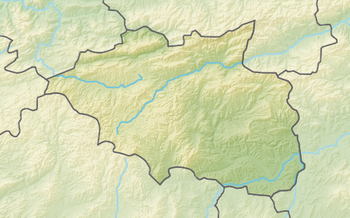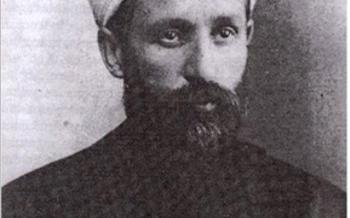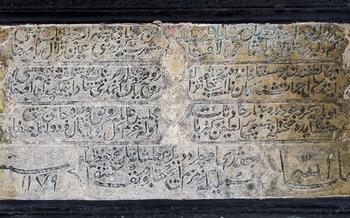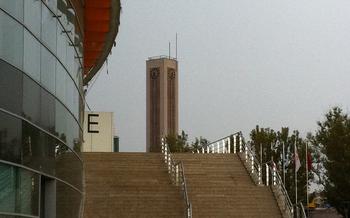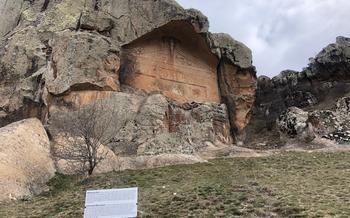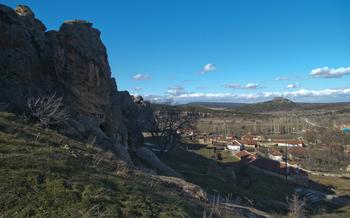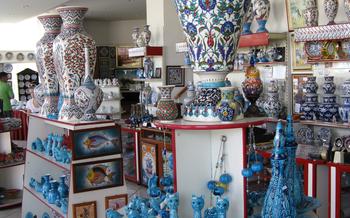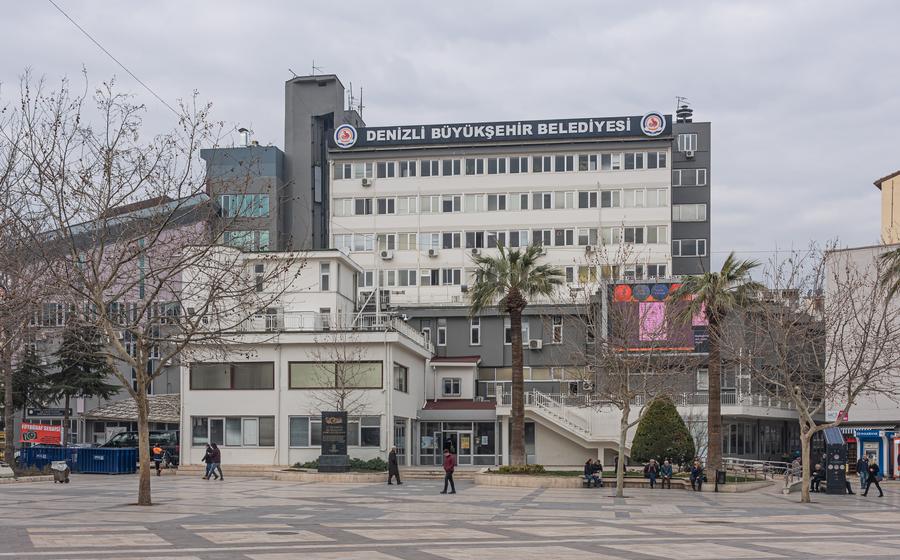
Yenicekent Bac Tomb
- Yenicekent Bac Tomb: An Overview
- Exploring the Tomb's History
- Unveiling the Architectural Wonders
- Inside the Tomb: Exploring the Interiors
- The Phrygian Civilization: A Legacy Revealed
- The Phrygian Valley: A Land of History and Nature
- Accessibility and Transportation
- Guided Tours and Professional Insights
- Tips for Photography Enthusiasts
- Cultural Significance and UNESCO Recognition
- Local Cuisine and Flavors of Denizli
- Accommodation Options Near the Tomb
- Responsible Tourism and Sustainable Practices
- Safety and Security Considerations
- Insider Tip: Unveiling Hidden Details
Yenicekent Bac Tomb: An Overview
The Yenicekent Bac Tomb, nestled in the historic Phrygian Valley of Denizli, Turkey, stands as a testament to the rich cultural heritage of the ancient Phrygian civilization. Dating back to the 6th century BCE, this monumental tomb is a remarkable example of Phrygian architecture and craftsmanship. Its unique beehive shape and intricate carvings have captivated visitors and archaeologists alike, making it a must-see destination for anyone interested in ancient history and archaeology.
Conveniently located just a short distance from the town of Yenicekent, the tomb is easily accessible by car or guided tour. Visitors can explore the tomb's exterior, marveling at its impressive size and well-preserved façade. The tomb's interior, though not accessible to the public, is believed to contain a burial chamber and various niches, offering a glimpse into the funerary practices of the Phrygians. The Yenicekent Bac Tomb is open to visitors daily, with a small admission fee for entry.
Exploring the Tomb's History
The Yenicekent Bac Tomb stands as a testament to the rich history and cultural heritage of the ancient Phrygian civilization. This remarkable burial site is nestled within the ancient city of Yenicekent, which flourished as a significant urban center during the Phrygian era. The tomb's construction and design reflect the Phrygians' architectural prowess and their unique religious beliefs and practices.
The Phrygians, an Indo-European people, migrated to Anatolia from the Balkans around the 12th century BC. They established a powerful kingdom that spanned much of central and western Anatolia. The Phrygians were skilled metalworkers, weavers, and traders, and they played a vital role in the region's trade and commerce.
The tomb's significance lies in its association with the Phrygian ruling class. It is believed to have been constructed for a high-ranking official or member of the royal family. The tomb's elaborate design and impressive dimensions reflect the power and prestige of the Phrygian elite.
Moreover, the tomb offers insights into the religious beliefs and practices of the Phrygians. The tomb's interior features a burial chamber and several niches, suggesting that the Phrygians practiced multiple burials within the same tomb. This custom reflects their belief in an afterlife where the deceased would continue to exist in a similar manner to their earthly lives.
The Yenicekent Bac Tomb stands as a tangible link to the ancient Phrygian civilization, providing valuable insights into their history, culture, and religious beliefs. It serves as a reminder of the rich and diverse heritage that Anatolia has to offer, inviting visitors to explore the depths of this fascinating and enigmatic ancient civilization.
Unveiling the Architectural Wonders
Distinctive features of the tomb's architecture, such as its beehive shape, immediately capture the attention of visitors. Constructed using locally sourced stones, the tomb displays remarkable craftsmanship and engineering. The beehive shape, a common feature in Phrygian architecture, provides structural stability and represents the cyclical nature of life and death.
The construction materials and techniques used in the tomb's construction showcase the advanced skills of the Phrygians. Large, carefully cut stone blocks were used to create the tomb's structure, demonstrating their mastery of stoneworking and construction. The use of corbelled arches, a technique where each successive layer of stones protrudes slightly over the one below, creates a distinctive and visually appealing effect.
Symbolism and motifs found in the tomb's design and decorations offer insights into the Phrygian worldview and beliefs. The intricate carvings and reliefs adorning the tomb's exterior often depict scenes from Phrygian mythology, religious rituals, and daily life. These motifs provide a glimpse into the cultural and spiritual significance of the tomb and the Phrygian civilization.
Comparisons with other Phrygian tombs reveal similarities in architectural style and design, demonstrating a shared cultural heritage. The Yenicekent Bac Tomb, however, stands out due to its exceptional preservation and the intricate details found in its carvings. It serves as a prime example of Phrygian funerary architecture and offers valuable insights into the craftsmanship and artistry of this ancient civilization.
Inside the Tomb: Exploring the Interiors
The interior of the Yenicekent Bac Tomb offers a glimpse into the burial practices and beliefs of the ancient Phrygians. The tomb consists of several chambers, each with its own unique features. The main chamber, known as the burial chamber, is the largest and most significant. It contains several niches, which were used to place the bodies of the deceased. The niches are carved into the walls of the chamber and are of various sizes and shapes. Some of the niches are large enough to accommodate multiple bodies, while others are smaller and were likely used for individual burials.
In addition to the burial chamber, the tomb also contains several smaller chambers that were likely used for storage or other purposes. These chambers are smaller and less elaborate than the burial chamber, but they still provide valuable insights into the lives of the Phrygians.
During excavations of the tomb, archaeologists discovered a number of artifacts, including pottery, jewelry, and weapons. These artifacts provide further evidence of the Phrygian culture and their burial practices. The tomb also contains a number of inscriptions, which have helped scholars to learn more about the Phrygian language and writing system.
The Yenicekent Bac Tomb is a valuable historical site that provides important insights into the Phrygian civilization. The tomb's interior is well-preserved and offers visitors a unique opportunity to explore the burial practices and beliefs of this ancient culture.
The Phrygian Civilization: A Legacy Revealed
The Phrygians, an ancient people who inhabited the central Anatolian region of Turkey, left behind a rich legacy that continues to captivate historians and archaeologists to this day. Their origins remain shrouded in mystery, but their influence on the region's history and culture is undeniable.
The Phrygians were skilled metalworkers, and their mastery of ironworking gave them a significant advantage in warfare. They established a powerful kingdom that stretched across much of central Anatolia, with Gordium as its capital. Their wealth and power were derived from their control over the region's trade routes, which facilitated the exchange of goods and ideas between the East and the West.
The Phrygians were also known for their elaborate religious beliefs and practices. They worshipped a pantheon of gods and goddesses, including Cybele, the Great Mother Goddess, and Dionysus, the god of wine and fertility. Their religious rituals often involved music, dancing, and the consumption of alcohol.
The Phrygians made significant contributions to the development of Anatolian culture. They adopted and adapted elements from other civilizations, such as the Hittites and the Greeks, creating a unique blend of influences. Their art and architecture showcased a distinctive style, characterized by intricate carvings, colorful murals, and monumental sculptures.
The Phrygian civilization eventually declined due to a combination of factors, including invasions by neighboring kingdoms and internal conflicts. However, their legacy lived on in the region. The Phrygians laid the foundation for the development of later Anatolian civilizations, and their cultural influence can still be seen in the region today.
The Phrygian Valley: A Land of History and Nature
Location and Geography: The Phrygian Valley, also known as the Midas Valley, is a picturesque region located in the western part of Turkey, within the boundaries of the Denizli province. The valley is renowned for its rich history, natural beauty, and stunning landscapes.
Historical Sites and Attractions: Dotted throughout the Phrygian Valley are numerous historical sites and attractions, each with its own unique significance. Visitors can marvel at the awe-inspiring rock-cut facades of Midas City, believed to be the ancient capital of the Phrygian kingdom. The valley is also home to several other Phrygian tombs, including the famous Midas Tomb, known for its intricate carvings and opulent decorations.
Natural Beauty and Landscapes: Beyond its historical treasures, the Phrygian Valley boasts breathtaking natural beauty. The valley is characterized by rolling hills, lush green meadows, and sparkling rivers, creating a picturesque landscape that is sure to captivate visitors. The valley's unique geological formations, such as the cascading waterfalls of Karhayıt, add to its natural allure.
Outdoor Activities and Exploration: The Phrygian Valley offers a range of outdoor activities for nature enthusiasts and adventure seekers. Visitors can embark on scenic hiking trails, winding through the valley's stunning landscapes. The valley is also a popular destination for mountain biking, offering challenging trails for riders of all skill levels. For those seeking a more leisurely experience, horseback riding is a great way to explore the valley's hidden corners.
Conclusion: The Phrygian Valley is a true gem of Turkey, blending history, nature, and outdoor adventure in perfect harmony. With its rich cultural heritage, captivating landscapes, and diverse activities, the valley offers an unforgettable experience for travelers seeking to explore the wonders of ancient Anatolia.
Accessibility and Transportation
Reaching the Yenicekent Bac Tomb is a convenient and straightforward journey from major cities in Turkey. Denizli, the nearest city, is approximately 60 kilometers away and offers various transportation options. Public buses provide regular service from Denizli's central bus station, making it an affordable and easily accessible choice. Alternatively, guided tours are available, departing from major cities like Istanbul, Ankara, or Izmir. These tours often include transportation, entrance fees, and expert commentary, providing a comprehensive and educational experience.
The estimated travel time from Denizli to the tomb is approximately 1 hour and 30 minutes by car or taxi. The route is well-maintained and offers scenic views of the Phrygian Valley. If driving, follow the signs towards Yenicekent village and then continue on the road leading to the tomb.
To fully immerse yourself in the history and culture of the region, consider extending your stay in the Phrygian Valley. Several nearby towns and cities, such as Çivril, offer a range of accommodation options and additional attractions. Plan your trip carefully, considering travel routes and schedules, to make the most of your visit to this fascinating historical site.
Guided Tours and Professional Insights
When visiting the Yenicekent Bac Tomb and the Phrygian Valley, the advantages of booking a guided tour are immeasurable. These tours provide visitors with an opportunity to gain profound insights into the historical significance, cultural context, and architectural wonders of the tomb. Local tour operators and guides who specialize in Phrygian history and culture bring the past to life with their expertise and passion. They illuminate the tomb's significance within the broader context of Phrygian civilization, shedding light on its religious beliefs, burial practices, and the society that built it. Guided tours offer a comprehensive understanding of the tomb's architecture, symbolism, and the fascinating history of the Phrygians.
For those seeking a truly immersive experience, guided tours are highly recommended. These tours provide invaluable insights that enhance the appreciation of the tomb's grandeur and the Phrygian Valley's cultural heritage. The cost of guided tours varies, but the investment is well worth the wealth of knowledge and understanding gained. It is advisable to book guided tours in advance, especially during peak tourist seasons, to secure a spot with the most experienced and knowledgeable guides.
Tips for Photography Enthusiasts
The Yenicekent Bac Tomb offers a unique opportunity for photography enthusiasts to capture stunning images of ancient architecture amidst a picturesque natural setting. Here are some tips to help you make the most of your photographic experience at the tomb:
-
Golden Hour Magic: Plan your visit during the golden hours, just after sunrise or before sunset, to capture the tomb's architecture in the most flattering light. The warm, diffused light during these times enhances the colors and textures of the stone, creating a dramatic effect.
-
Camera Settings: Use a wide-angle lens to capture the tomb's imposing presence against the backdrop of the valley. Experiment with different shutter speeds to create a sense of movement or freeze the moment. A sturdy tripod will help you achieve sharp images, especially in low-light conditions.
-
Composition and Angles: Explore various angles to find unique perspectives of the tomb. Shoot from below to emphasize its grandeur, or capture it from a distance to showcase its relationship with the surrounding landscape. Use leading lines, such as the pathway leading to the tomb, to draw the viewer's eye towards the main subject.
-
Capturing the Valley's Beauty: Don't limit yourself to the tomb alone. The Phrygian Valley offers breathtaking natural beauty. Capture the rolling hills, lush vegetation, and the distant mountains that frame the tomb. Experiment with panoramic shots to capture the vastness of the landscape.
Cultural Significance and UNESCO Recognition
The Yenicekent Bac Tomb stands as a testament to the rich cultural heritage of Turkey and has gained global recognition for its exceptional historical value. In 1994, UNESCO inscribed the tomb on its prestigious World Heritage List, solidifying its status as a site of outstanding universal importance.
The tomb's inclusion on the World Heritage List was based on several criteria:
Historical and Cultural Significance: The tomb is an exceptional example of Phrygian funerary architecture and provides valuable insights into the cultural practices and beliefs of this ancient civilization.
Unique Architectural Features: The tomb's distinctive beehive shape and intricate carvings set it apart from other Phrygian tombs and showcase the remarkable craftsmanship of its builders.
Intact Condition: Despite its age, the tomb remains remarkably well-preserved, offering a rare glimpse into ancient funerary practices and allowing visitors to experience the grandeur of Phrygian architecture firsthand.
The recognition of the Yenicekent Bac Tomb as a UNESCO World Heritage Site underscores its importance not only to Turkey but to the entire world. It serves as a reminder of the cultural diversity and richness of Turkey's past and highlights the need to protect and preserve this precious heritage for future generations.
Local Cuisine and Flavors of Denizli
Denizli, the home of the Yenicekent Bac Tomb, offers a rich culinary experience that blends traditional Turkish cuisine with local flavors. Visitors can indulge in mouthwatering dishes that showcase the region's fresh produce, spices, and culinary traditions.
Traditional Delights:
- Çoban Kavurma: Tender lamb meat slow-cooked with tomatoes, peppers, and onions, served with fragrant rice.
- Gözleme: A savory pastry filled with spinach, cheese, or minced meat, cooked on a traditional saç.
- Düğün Çorbası: A hearty wedding soup made with lamb or chicken broth, chickpeas, and vermicelli.
Local Specialties:
- Acılı Ezme: A spicy dip made from roasted peppers, walnuts, and garlic, perfect with fresh bread.
- Denizli Kebabı: Grilled lamb skewers marinated in yogurt and spices, served with grilled vegetables.
- Çiğdem Böreği: A flaky pastry filled with çiğdem (squill) greens and cheese, a local specialty.
Sweet Indulgences:
- Afyon Kaymağı: A thick and creamy clotted cream, a regional delicacy often served with honey or fruit.
- Şekerpare: Bite-sized semolina cookies soaked in syrup, a popular sweet treat.
- Lokum: Turkish delight, a soft and chewy confection made with sugar, starch, and flavorings.
Vegetarian Options:
- Mercimek Köftesi: Lentil meatballs made with red lentils, herbs, and spices, a delicious meat-free alternative.
- Zeytinyağlı Enginar: Artichokes cooked in olive oil with lemon juice and fresh herbs, a light and flavorful dish.
- Kabak Çiçeği Dolması: Stuffed zucchini flowers with rice, herbs, and spices, a delicate and flavorful appetizer.
Tips for Food Lovers:
- Visit Local Markets: Explore the vibrant local markets for fresh produce, spices, and traditional ingredients.
- Try Street Food: Sample delicious street food like gözleme, kebabs, and simit (sesame bread) from local vendors.
- Ask for Recommendations: Don't hesitate to ask your hotel or tour guide for recommendations on local restaurants.
- Enjoy the Experience: Savor the unique flavors and culinary traditions of Denizli, an essential part of the travel experience.
Accommodation Options Near the Tomb
Yenicekent Bac Tomb, a UNESCO World Heritage Site, draws visitors from around the world. To fully immerse yourself in the history and culture of the region, consider staying overnight. Fortunately, there are several accommodation options to suit different preferences and budgets.
For a comfortable stay, the Yenicekent Village Hotel offers modern amenities and stunning views of the Phrygian Valley. If you prefer a more traditional experience, opt for one of the charming guesthouses in the village, such as the Bac Tomb Guesthouse, which provides a glimpse into local life.
For those seeking a unique experience, consider booking a room at the Phrygian Rock Cave Hotel. Carved into the rock formations, these cave rooms offer an authentic and unforgettable stay.
Budget travelers can find affordable options at the Yenicekent Hostel, which provides basic accommodations and a friendly atmosphere.
When choosing your accommodation, consider the distance from the tomb. Some hotels, like the Yenicekent Valley Hotel, are just a short walk away, while others may require transportation.
To ensure a memorable stay, book your accommodation in advance, especially during peak tourist season. Don't miss this opportunity to immerse yourself in the history and beauty of the Phrygian Valley.
Responsible Tourism and Sustainable Practices
As you embark on your journey to the Yenicekent Bac Tomb, it is essential to embrace responsible tourism practices to preserve its cultural heritage and natural surroundings. Respect the tomb's sanctity and refrain from touching or damaging any of its structures or artifacts. Adhere to designated pathways to avoid disturbing the site's delicate ecosystem. Minimize your environmental impact by carrying reusable water bottles and avoiding single-use plastics. Support local businesses and initiatives that promote sustainable tourism practices, such as eco-friendly accommodation and guided tours that prioritize conservation. By embracing responsible tourism, you contribute to the preservation of this remarkable historical site for generations to come.
Safety and Security Considerations
When embarking on any journey, safety should always be a top priority. Turkey is generally a safe country for travelers, but it's essential to take necessary precautions to ensure a smooth and secure visit to the Yenicekent Bac Tomb. Here are some safety tips to keep in mind:
-
Be aware of your surroundings: Stay alert and pay attention to your surroundings, especially in crowded areas. Keep an eye on your belongings and avoid displaying valuables openly.
-
Respect local customs: Turkey is a Muslim-majority country, and it's important to be respectful of local customs and traditions. Dress modestly, avoid public displays of affection, and be mindful of religious practices.
-
Stay hydrated: The Phrygian Valley can get quite hot and dry, so make sure to stay hydrated by carrying a water bottle with you.
-
Emergency contact information: Keep emergency contact information handy, including local police and medical services. It's also a good idea to inform your hotel or tour guide about your travel plans.
-
Stay informed: Keep yourself updated on local news and safety updates. Monitor official travel advisories and stay informed about any potential risks or changes in the security situation.
By following these safety tips and exercising common sense, you can ensure a safe and enjoyable visit to the Yenicekent Bac Tomb and the surrounding region.
Insider Tip: Unveiling Hidden Details
Beyond the visible wonders of the Yenicekent Bac Tomb, there lies a treasure trove of hidden details waiting to be discovered by curious travelers. Look closely at the tomb's facade, and you might spot intricate carvings or symbols that hold clues to the Phrygian civilization's beliefs and practices. The tomb's interior also reveals hidden niches and chambers that may have served specific purposes in ancient rituals or ceremonies.
For those seeking a deeper understanding of the tomb's significance, I recommend delving into the works of renowned archaeologists and historians who have studied the Phrygian civilization extensively. Books like "The Phrygians: History and Legacy" by Dr. Mehmet Özdoğan provide a wealth of information and insights into the tomb's context and its role in Phrygian culture.
Unveiling the hidden details of the Yenicekent Bac Tomb is a journey of discovery that enriches the overall experience of visiting this ancient site. Whether you're an enthusiast of history, architecture, or simply curious about the secrets of the past, there's always something new to uncover at this remarkable tomb.
